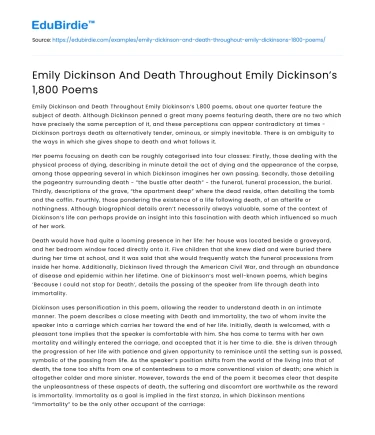Emily Dickinson and Death Throughout Emily Dickinson’s 1,800 poems, about one quarter feature the subject of death. Although Dickinson penned a great many poems featuring death, there are no two which have precisely the same perception of it, and these perceptions can appear contradictory at times - Dickinson portrays death as alternatively tender, ominous, or simply inevitable. There is an ambiguity to the ways in which she gives shape to death and what follows it.
Her poems focusing on death can be roughly categorised into four classes: Firstly, those dealing with the physical process of dying, describing in minute detail the act of dying and the appearance of the corpse, among those appearing several in which Dickinson imagines her own passing. Secondly, those detailing the pageantry surrounding death - “the bustle after death” - the funeral, funeral procession, the burial. Thirdly, descriptions of the grave, “the apartment deep” where the dead reside, often detailing the tomb and the coffin. Fourthly, those pondering the existence of a life following death, of an afterlife or nothingness. Although biographical details aren’t necessarily always valuable, some of the context of Dickinson’s life can perhaps provide an insight into this fascination with death which influenced so much of her work.
Save your time!
We can take care of your essay
- Proper editing and formatting
- Free revision, title page, and bibliography
- Flexible prices and money-back guarantee
Death would have had quite a looming presence in her life: her house was located beside a graveyard, and her bedroom window faced directly onto it. Five children that she knew died and were buried there during her time at school, and it was said that she would frequently watch the funeral processions from inside her home. Additionally, Dickinson lived through the American Civil War, and through an abundance of disease and epidemic within her lifetime. One of Dickinson’s most well-known poems, which begins ‘Because I could not stop for Death’, details the passing of the speaker from life through death into immortality.
Dickinson uses personification in this poem, allowing the reader to understand death in an intimate manner. The poem describes a close meeting with Death and Immortality, the two of whom invite the speaker into a carriage which carries her toward the end of her life. Initially, death is welcomed, with a pleasant tone implies that the speaker is comfortable with him. She has come to terms with her own mortality and willingly entered the carriage, and accepted that it is her time to die. She is driven through the progression of her life with patience and given opportunity to reminisce until the setting sun is passed, symbolic of the passing from life. As the speaker’s position shifts from the world of the living into that of death, the tone too shifts from one of contentedness to a more conventional vision of death; one which is altogether colder and more sinister. However, towards the end of the poem it becomes clear that despite the unpleasantness of these aspects of death, the suffering and discomfort are worthwhile as the reward is immortality. Immortality as a goal is implied in the first stanza, in which Dickinson mentions “Immortality” to be the only other occupant of the carriage: although it is only in the final stanza that the speaker achieves this goal.
The meaning of time becomes lost, and hundreds of years are no different from a day to the speaker. As time has lost its meaning, the speaker is able to appreciate the instant in which they realise that death is not merely death, but is in fact immortality, for she “surmised the Horses’ Heads/Were toward Eternity -”. In ending the poem with a dash following ‘eternity’, Dickinson here shows a representation of eternity; a poem which does not end, and is left in a momentary pause for eternity.






 Stuck on your essay?
Stuck on your essay?

